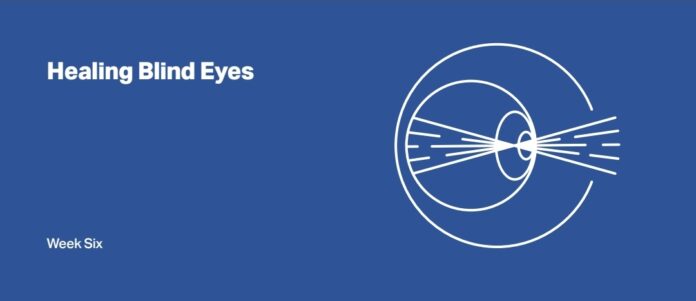The Gospel of John | Week 06 – HEALING BLIND EYES
Week’s Passage: John 9 and 10
- InTro
- Conflict Intensifies
John 7-10 captures the last months of Jesus’ life. He returns to Jerusalem for the Feast of Booths despite threats against Him. He engages in debates, affirming His divine connection, which leads to tension over His true identity and origin. In this context, John includes the story of the woman caught in adultery, revealing Jesus’ merciful approach to judgment, then continues His ministry under constant threat until his final visit for Hanukkah.
- inGest
- Washing in the pool
In John 9-10, Jesus heals a blind man, challenging common beliefs that suffering is caused by personal or parent’s sin. He explains that the man’s blindness serves to reveal God’s power.
His healing method of mixing clay and saliva suggests is symbolic to creation, and as only Jesus, sent (The pool’s name) by the Father can remove both physical and spiritual blindness. This miracle on Sabbath causes division among Pharisees who reject Jesus’ authority despite clear evidence. This story warns against spiritual blindness. Urging us to walk in the light rather than observing it.
- inTerpret
- Interrogating the Witness
In John 9, the healed man’s parents avoid confirming how he was healed out of fear of being expelled from the synagogue. When the Pharisees press the man himself, he boldly insists that Jesus must be from God, frustrating the leaders. Jesus later finds the man, leading him to confess his faith and worship Him as Messiah. This account contrasts the man’s growing spiritual sight with the Pharisees’ willful blindness, echoing Revelation’s warning to Laodicea (Rev 3:14-22) true sight requires humility and willingness to fully embrace God’s truth.
- inVite
- The Good Shepherd
John 10:1–21, Jesus, following the healing in John 9, contrasts Himself with the Pharisees by using the metaphor of the Good Shepherd, emphasizing His caring relationship with believers. Unlike the “blind” religious leaders, Jesus is the true shepherd who leads, protects, and knows His sheep. He also describes Himself as the door, the access point to safety and life. This fulfills Old Testament prophecies of a promised shepherd (Ezekiel 34). While some listeners understood, others remained resistant. Jesus continues to call those willing to follow, offering abundant life and the Himself as a sacrifice to his sheep.
- inSight
- A Great Sinner
Ellen G. White (The Desire of Ages [1898] highlights the Jewish belief that suffering is a direct punishment for sin, which contributed to their rejection of Jesus. The Pharisees’ challenges to the healed blind man inadvertently opened the eyes of many to Jesus’ true nature. Despite their efforts to undermine him, the man stood firm in his faith, aided by divine strength. She further emphasize that Jesus’ compassion endures, as He continues to care deeply for humanity and holds His followers securely. However, she cautions that many believers, especially the youth, are complacent and unaware of their spiritual blindness, failing to bear fruit for God’s glory.
inQuire
• Once again, Jesus healed on the Sabbath. Do you think this was deliberatively provocative, or was another motive at work?
• Jesus said He came to bring abundant life and joy (John 10:10). Have you experienced this in your life? What could you do to increase your “joy in the Lord” (Neh. 8:10)?
• What is your greatest hindrance to recognizing your spiritual blind spots?
• Take a moment to enter a prayerful state of mind. Meditate on John 10:25–30. What parts of this passage are meaningful to you?



